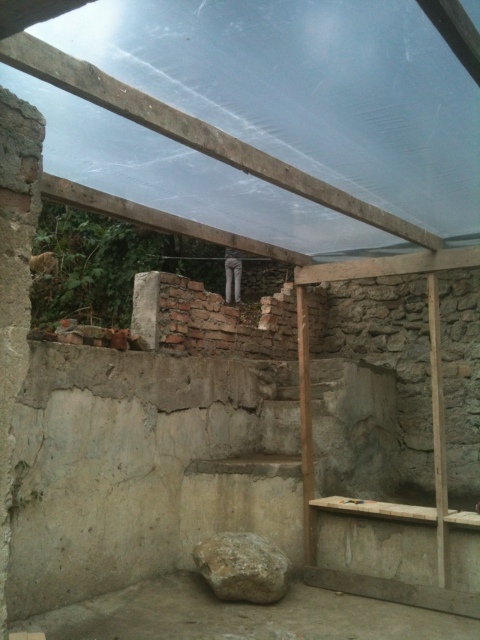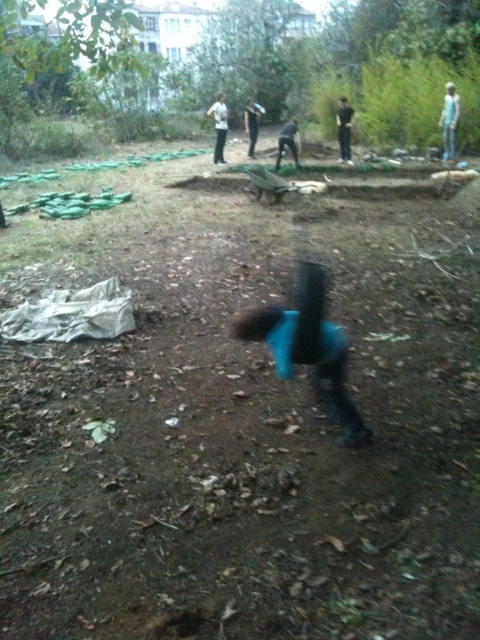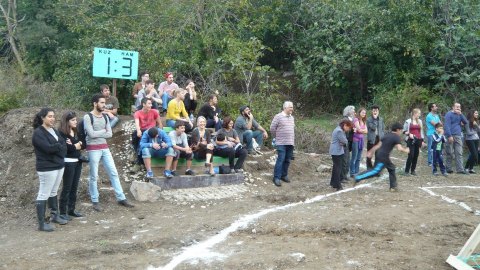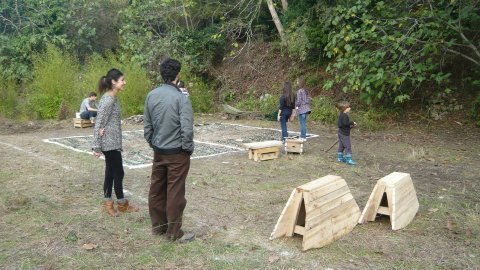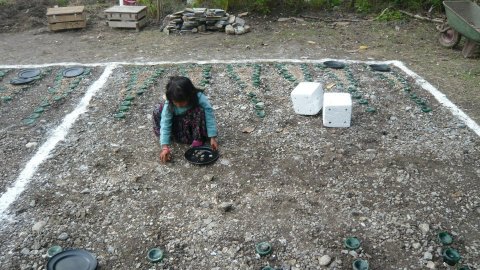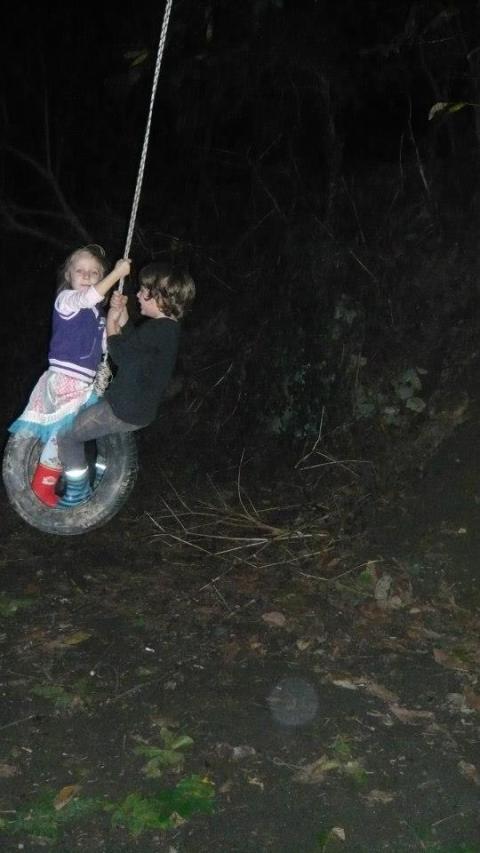2012/12: NCR-07 [Ekoloji]: Kahraman Bostan Dönüşen İstanbul’a Karşı / Orchard the Brave Versus Transforming Istanbul / New City Reader
Aralık 18, 2012 § Yorum bırakın
Konuk editörlüğünü Şevin Yıldız’ın yaptığı, 7. New City Reader gazetesi Ekoloji İstanbul sokaklarında. Bu sayıya katkılda bulunalar Sonay Aykan, Boğaçhan Dündaralp, John May, David Harvey, Pelin Tan ve Ayşe Çavdar.
Guest edited by Şevin Yıldız, the NCR-07 [Ecology] is out on the streets of Istanbul. The issues contributers are Sonay Aykan, Boğaçhan Dündaralp, John May, David Harvey, Pelin Tan and Ayşe Çavdar.
Boğaçhan Dündaralp, New City Reader’ın 7. sayısı Ekoloji için Kuzguncuk Bostanı’nın hikayesini yazdı:
İstanbul son 10 yıldır,belki de küresel kapitalizm ve neoliberal politikalar pençesindeki pek çok kent gibi, kent peyzajının dönüştürüldüğü, yeniden üretildiği bir sürecin içinde. Bu süreç yalnızca fiziki değil; sosyal ve ekolojik açıdan kent parçalarını yeniden tanımlıyor, biçimlendiriyor. Özel mülkiyeti, tüketimi, otoriter yapılaşmayı öncelikli hale getirerek kamusal alanları tehdit eden ve tehdit etmekle de kalmayıp TOKİ gibi mekanizmalarla kamusal alanları özel mülkiyetlere dönüştüren, kentin doğal kaynaklarını yok eden; sosyal ayrıştırma ve yerinden etme mekanizmalarının işlediği bir ortam.Sosyal ve ekolojik krizlerin kaynağı haline gelen bu ortamda ‘tasarım’, ‘yer’in kendi gerçekliğini yok sayan, yoğun estetizasyon ve yeniden işlevlendirmeyle olageleni meşru kılan bir araç gibi; ‘tasarımcı’ da yaratıcılığı bu yönde teşvik edilen pasif ve uzlaşmacı bir rolde kullanılmaktadır.
Kentli olma haklarının ihlal edildiği,birbirinden izole edilmiş, tüketim odaklı, yapay ve homojen peyzaj fragmanlarına dönüşmeye başlayan bir kentiçin kuşkusuz en çarpıcı sonuç, kentlerde alternatif yaşam ve özgürleşme olanaklarının giderek yok edilmesidir. ‘Yer’ duygusunun hissedilebildiği,kendine göre bir hayat ritmi, yaşama biçimi olan, katmanlı, üretken kent peyzajlarının tıpkı kentin doğal kaynakları gibi kaynaklarından kopartılması,yok edilmesi giderek artmaktadır. Kentler kendi kültürel birikimini doğurduğu devinim ve zenginliklerini, etkileşime dayalı ağları ve üretkenliklerini kaybetmektedir.
Kuzguncuk Bostanı’nın hikayesi böyle bir ortamdaki direniş mücadelesidir. Bu hegemonik kent peyzajı üretiminde gücünü ‘yer’ den alan kendi kültürel ve sosyal birikimini kullanarak; kendinin ve kentinin doğal kaynaklarından biri olan ‘bostan’ını korumaya çalışan Kuzguncukluların hikayesi…
İstanbul – Kuzguncuk
Kuzguncuk; İstanbul’un yoğun yapılaşma, sürekli ve hızlı dönüşüm trafiğinden ya da sondönemlerdeki kentsel dönüşüm adı altında yapılan tepeden inme ‘soylulaştırma’, ‘yerinden etme’, ‘değer arttırma’ gibi kentsel operasyonlardan kendini koruyabilmiş, ‘yavaş’ dönüşüm yaşayan, otantik varoluşunu, dokusunu, karakterini koruyarak gelişen, İstanbul’da kalan belki de tek boğaz köyü. “Bunu nasıl başarıyor?” sorusunu sorarsak, bunun iki tane temel yanıtı var. Birincisi İstanbul’daki topoğrafik konumu.Bir yanda Fethipaşa Korusu, diğer yanda Nakkaşbaba Mezarlığı arasında bir vadiye yerleşen köy, Bağlarbaşı tarafında arka uçtaki kentsel gelişmeden kısmen kendini topoğrafik sınırlarla yalıtabilmiştir. Bu sınırlar içindeki fiziksel-karakteristik dokusu ‘sit alanı’ kapsamında da korununca; yıkılmadan yenilenerek varolmayı zorunlu kılan alçak katlı, eski eser ağırlıklı bir doku olarak konumunu sürdürebiliyor. İkincisi, bu doku sayesinde 1980’lerden başlayarak ciddi bir entelektüel göç alarak buradaki doku hem yenileniyor hem de yaşayanlar anlamında yeni komşuluk ilişkileri üretiyor. Bu entelektüel göç, gün geçtikçe artmasına rağmen hızlı bir dönüşümle değil; müzakere, karşılaşma, kabullenme, karşılıklı birbirinin varlığını kabul ederek ilerleyen bir süreçle gerçekleşiyor. Bu nedenle neo-liberal ekonomilerle üretilen hızlı kentsel dönüşümlerde olduğu gibi alt-ekonomiyi, ekonomik dengesizlikleri, komşuluk ilişkilerini ortadan kaldıran, bölgeler arası ekonomik göstergeleri uçlara taşıyan ayrışmalar burada gözlemlenmiyor. Onun bu koşullarda İstanbul gibi hızlı dönüşümün yaşandığı bir kentte kendi kimliğini koruyarak ağır evrimleşmesi; bir taraftan kentleşme ile kaybedilen pek çok olgunun hala varolabildiği bir yaşam alanını temsil etmesini sağlıyor, diğer taraftan da onun bu kimliğini gözler önüne sunan TV dizileri, reklamlar sayesinde de bir turistik cazibe merkezi haline geliyor.
Kuzguncuk – Bostan
Bostan, ‘namı diğer İlya’nın Bostanı’ ise bu kentsel doku içinde kalan, son yeşil boşluk olarak hem yerel yönetimler, hem de ekonomik iktidarların İstanbul’un hızlı kentsel dönüşümünün Kuzguncuk’taki anahtarı olarak her 10 yılda bir gündeme taşınıyor. Bostan olarak korunması gerekli bu alan; İmar Planlarında 1980’lerin ikinci yarısında yapılan oynamalar sonucu bunlara karşı açılan davalar gibi hukuki düzlemlerde de verilen savaşlarla, 1990’da ve 2000’de buradaki bilinçli yerel oluşumlar sayesinde korunabilmiş ve 2010’da tekrar bu alan üzerindeki planlar gündeme gelmiştir. 2012’de mülkiyet hakkını elinde tutan Vakıflar Genel Müdürlüğü tarafındanbostan alanını kaplayan, kitlesi ve programı ile uyumsuz, kamusal kullanımlara kapalı birözel okul projesi hazırlatılarak hayata geçmesi için bir girişimde bulunulmuştur.Kuzguncuklular bu girişim sonrasında bir taraftan hukuki, bir taraftan sosyal (şenlik, ortak üretim, çeşitli workshoplar, farklı medya üretimleri), bir taraftan da alternatif bir proje üreterek hazırlatılan projeye karşı çıktılar.
Alternatif olunan projenin hem yapısal durumuna hem de kentteki bir alanın ‘değer’ine ilişkin bugünün kent politikaları, kentleşme modelleri üzerinden yeni bir müzakere alanı açılarak, bu alana ilişkin yaklaşımların ‘tek bir model’ üzerinden yapılamayacağını göstermeye çalıştılar. ‘Mülkiyet hakkı’ndan çok ‘kullanım hakkı’na odaklanarak, tarafları yeni bir müzakere alanına taşımaya çalıştılar. Bu çaba ile Bostan’ın sahip olduğu değerleri kaybetmeden yaşatılabileceği alternatif modellerin de mümkün olabileceğini ve bu yönde ortak bir çaba içine girebileceklerini gösterdiler.
Tüm proje onay süreçlerin takip eden, kurumlarla iletişimini kaybetmeyen Kuzguncuk İttifakı sürekli tetikte ve proje ile ilgili gelişmeleri izlerken; 28.06.2012’de Kültür Ve Turizm Bakanlığı, İstanbul 6 Numaralı Kültür Varlıklarını Koruma Bölge Kurulu, Kuzguncuk bostanında yapılmak istenen ilköğretim tesis alanı yapılaşma başvurusunu; programı ve yapı kütlesi nedeni ile Kuzguncuk mimari dokusuna uyumlu olmaması gerekçesiyle uygun olmadığına, ayrıca parsel içinde tespit edilen bostan havuzunun korunması gerekli kültür varlığı olarak tescil edilerek koruma grubunun 2.grup olarak belirlenmesine karar verdi.
Kuzguncuklular bu kararla biraz nefes aldılar, zaman kazandılar ancak süreç de direniş de bitmiş değil.
İlgilenenler için: https://bogachandundaralp.wordpress.com/?s=bostan
Here is Boğaçhan Dündaralp’s text for the 7th issue of the New City Reader [Ecology]:
In the last 10 years, perhaps similar to many other cities in the grip of global capitalism and neoliberal policies, Istanbul is a part of a process through which urban landscape is transformed and reproduced. This process redefines and shapes urban segments in social and ecological, not just in physical, terms. It is a context defined by the mechanisms of social segregation and exclusion; a context, which threatens public spaces by prioritizing private property, consumption and authoritarian urban design. Moreover, going beyond intimidation, the process transforms public spaces into private property by using mechanisms such as TOKİ, and destroys the natural resources of the city. In this context that became a source of social and ecological crises, “design” is used as a tool that ignores the realities of the “place”, legitimizes the prevalent through intense aestheticisation and refunctionalization; and the “designer” is used in a passive and reconciliatory role that encourages creativity along these lines.
Without a doubt, the most striking result for a city in which the rights to be an urban resident is violated, a city which is turning into isolated, consumption-oriented, artificial and homogenized landscape fragments, is the gradual annihilation of the possibilities for an alternative urban life and emancipation. Just like the natural resources of the city, multi-layered and productive urban landscapes that have a peculiar rhythm and way of life, in which the feeling of “place” can be experienced, are being ripped off from their sources and destroyed. Cites are losing their cultural heritage that arises from mobility and wealth, their networks based on interaction and their productiveness.
The story of Kuzguncuk Orchard is a resistance struggle that takes place in a context like this. It is the story of the residents of Kuzguncuk who against this hegemonic urban landscape, try to protect their “bostan” which is one of the natural resources of the city and their life, by using their cultural and social values that takes their power from “place”…
Istanbul – Kuzguncuk
Kuzguncuk is perhaps the only village left by the Bosporus, which could protect itself from urban operations such as dense housing, continuous and rapid traffic of transformation, “gentrification” that has been going on for a while under the euphemism of urban renewal, “dislocation”, and “value enhancement”. It experiences a “slow” transformation, and develops while maintaining its authentic existence, texture and character. There are two basic answers to the question “how does it achieve this?” First answer is the topographical position of Istanbul. Located in a valley between Fethipasa grove and Nakkasbaba cemetery, the village, thanks to its topographical borders, could partially isolate itself from the urban development that has been taking place at the rear edge of Baglarbasi. Thanks to its characteristic texture in physical terms and its “historical site” status, it was protected within these borders and it remains as a texture dominated by historical landmarks and low-rises that necessitate a renovation without destruction. Second, because of this texture, beginning with the 1980s, it has received a significant intellectual migration, which regenerates the texture here and creates new neighbourhood relations. This intellectual migration increases everyday and it does not happen through a rapid transformation, but through negotiation, encounters, acceptance, and a process of mutual recognition. As a result, unlike rapid urban transformations induced in neoliberal economies, disintegration that destroys sub-economy, neighbourly relations and economic balances, inter-regional disparities are not observed here. On the one hand, its slow evolution and preservation of its identity in a context like rapidly transforming Istanbul, makes it an example of a life space in which most of the phenomena sacrificed for urban transformation can persevere. And on the other hand, thanks to the TV series and commercials that disclose its identity, it becomes a centre of attraction for tourists.
Kuzguncuk – Orchard
Also known as “Ilya’s Orchard”, the orchard is the last remaining piece of green land within this urban texture, which is a fact that brings it to the agenda every 10 years as a key to rapid urban transformation demanded by local authorities and the economic government. This area, which supposed to be protected as an orchard, could be preserved thanks to the lawsuits for the stay of execution against the changes in the master plan in the second half of the 1980s and to conscious neighbourhood organizations emerged in the 1990s and 2000s. However, in 2010, plans for transformation of the area came back to agenda. In 2012, the General Directorate for Foundations, who holds the property rights to the orchard, designed a project for construction of a private school, which occupied the whole plot and was inharmonious due to its mass and programme. Kuzguncuk residents resisted this project by initiating a legal struggle, organizing social events (including festivals, common production, various workshops and different media productions) and proposing an alternative project.
By generating a new space for a discussion on the structural conditions of the imposed project, the “value” of the area and contemporary models of urban policies and urbanization, they tried to show that the negotiations about the future of the area could not be carried out through a single proposal. Focusing on “right to use”, rather than “property rights”, they aimed to invite the parties in a novel field of negotiation. With this effort, they showed that the orchard could be preserved without losing its richness, alternative models were possible and these models could be pursued through a common endeavour.
While following up on project approval processes and maintaining their communication with related institutions, Kuzguncuk Coalition stays on alert and monitors the developments about the project. On 28.06.2012, Ministry of Culture and Tourism, Cultural Heritage Preservation Regional Board, 6th Bureau of Istanbul, decided that the project that stipulates the construction of a primary school on the plot occupied by the orchard was not compatible with the architectural texture of Kuzguncuk because of its programme and structural mass. In addition, the Bureau resolved that the orchard pool detected in the plot was a cultural landmark and should be protected under 2nd group status.
Kuzguncuk residents were relieved with this decision and gained some time, however neither the process, nor the resistance has reached to a conclusion yet…
For further information: https://bogachandundaralp.wordpress.com/?s=bostan
linkler:
EN:
http://istanbuldesignbiennial.iksv.org/7th-issue-of-the-new-city-reader-ecology-is-out/
TR:
http://istanbuldesignbiennial.iksv.org/7th-issue-of-the-new-city-reader-ecology-is-out/?lang=tr
2012/11: Kamusal Destekli Tasarım Atölyesi / Deneysel Tasarım Stüdyosu, HFBK Hamburg /Adhokrasi, İstanbul Tasarım Bienali
Aralık 4, 2012 § 1 Yorum
Public Design Support Kuzguncuk, Studio for Experimental Design HFBK Hamburg, Adhocracy, Istanbul Design Biennial
Kuzguncuk: Bostan; Kamusal Destekli Tasarım;Workshop
*İstanbul_Kuzguncuk
Kuzguncuk; İstanbul’ un yoğun yapılaşma, sürekli ve hızlı dönüşüm trafiğinden ya da son dönemlerdeki kentsel dönüşüm adı altında yapılan tepeden inme ‘gentrification’ ya da soylulaştırma’, ‘yerinden etme’, ‘değer arttırma’ gibi kentsel operasyonlardan kendini koruyabilmiş, ‘yavaş’ dönüşüm yaşayan, otantik varoluşunu, dokusunu, karakterini koruyarak gelişen, Istanbul’ da kalan belki de tek boğaz köyü. “Bunu nasıl başarıyor?” sorusunu sorarsak, bunun iki tane temel yanıtı var. Birincisi İstanbul’ daki topoğrafik konumu: bir yanda Fethipaşa korusu, diğer yanda Nakkaşbaba mezarlığı arasında bir vadiye yerleşen köy, Bağlarbaşı tarafında arka uçtaki kentsel gelişmeden kısmen kendini topoğrafik sınırlarla yalıtabilmiştir. Bu sınırlar içindeki fiziksel-karakteristik dokusu ‘sit alanı’ kapsamında da korununca; yıkılmadan yenilenerek varolmayı zorunlu kılan alçak katlı, eski eser ağırlıklı bir doku olarak konumunu sürdürebiliyor. İkincisi bu doku sayesinde 1980’lerden başlayarak ciddi bir entelektüel göç alarak buradaki doku hem yenileniyor hem de yaşayanlar anlamında yeni komşuluk ilişkileri üretiyor. Bu entelektüel göç, gün geçtikçe artmasına rağmen hızlı bir dönüşümle değil; müzakere, karşılaşma, kabullenme, karşılıklı birbirinin varlığını kabul ederek ilerleyen bir süreçle gerçekleşiyor. Bu nedenle neo-liberal ekonomilerle üretilen hızlı kentsel dönüşümlerde olduğu gibi alt-ekonomiyi, ekonomik dengesizlikleri, komşuluk ilişkilerini ortadan kaldıran, bölgeler arası ekonomik göstergeleri uçlara taşıyan ayrışmalar burada gözlemlenmiyor. Onun bu koşullarda İstanbul gibi hızlı dönüşümün yaşandığı bir kentte kendi kimliğini koruyarak ağır evrimleşmesi; bir taraftan kentleşme ile kaybedilen pek çok olgunun hala varolabildiği bir yaşam alanını temsil etmesini sağlıyor, diğer taraftan da onun bu kimliğini gözler önüne sunan Tv dizileri, reklamlar, sayesinde de bir turistik cazibe merkezi haline geliyor.
*Kuzguncuk_Bostan
Bostan ise bu kentsel doku içinde kalan, son yeşil boşluk olarak hem yerel yönetimler, hem de ekonomik iktidarların İstanbul’un hızlı kentsel dönüşümünün Kuzguncuk’ taki anahtarı olarak her 10 yılda bir gündeme taşınıyor. Bostan olarak korunması gerekli bu alan; İmar Planlarında 1980’lerin ikinci yarısında yapılan oynamalar sonucu bunlara karşı açılan davalar gibi hukuki düzlemlerde de verilen savaşlarla, 1990’ da ve 2000’ de buradaki bilinçli yerel oluşumlar sayesinde korunabilmiş ve 2010’da tekrar bu alan üzerindeki planlar gündeme gelmiştir. Mülkiyet hakkını elinde tutan Vakıflar Genel Müdürlüğü tarafından bu alana bir proje hazırlatılarak, hayata geçmesi için bir girişimde bulunulmuştur.
*BostanA Alternatif Proje Girişimi
BostanA Alternatif Proje Girişimi ise, bu projeye alternatif olarak, alanın hem kullanımını hem de kullanım potansiyellerini alanın karakteri bozulmadan nasıl sürdürebileceğini göstermek amacı ile başlatılmıştır. Katılımcı bir süreçle geliştirilmeye başlanan bu çalışma, bir taraftan Bostan’ ın süregiden yaşantısını katılımlarla zenginleştirerek teorik bir egzersizden çok, pratik uygulamaya dair yeni üretim olanaklarını ve ekonomi modellerini ortaya koymaya çalışmaktadır. Kent platformunda, kimliğini koruyarak açığa çıkaracağı kamusal kullanımlarla hem Kuzguncuk’ a hem de İstanbul’ a yeni kentsel kullanımlar sunabilecek; ortaya koyduğu ekonomik model ile bir kent parçasının ‘değer’ ine ilişkin yeni bir öneri sunabilecektir. Mimarların sosyal bir aktör (katalizör) ve mimarlığın bir iletişim aracı olduğu bu çalışma ile; alternatif olunan projenin hem yapısal durumuna hem de kentteki bir alanın ‘değer’ine ilişkin bugünün kent politikaları, kentleşme modelleri üzerinden yeni bir müzakere alanı açılarak, bu alana ilişkin yaklaşımların ‘tek bir model’ üzerinden yapılamayacağı gösterilmeye çalışılmaktadır. ‘Mülkiyet hakkı’ ndan çok ‘kullanım hakkı’ na odaklanan bu çalışma, tarafları yeni bir müzakere alanına taşıyarak, Bostan’ ın sahip olduğu değerleri kaybetmeden yaşatılabileceği alternatif modeller üretmeye zorlayabilirse görevini başarı ile yapabilmiş olacaktır.
Süreç:
Bu çaba ile Kuzguncuk ittifakı, Bostan’ ın sahip olduğu değerleri kaybetmeden yaşatılabileceği alternatif modellerin de mümkün olabileceğini ve bu yönde ortak bir çaba içine girebileceklerini gösterdi. Tüm proje onay süreçlerini takip ederek, kurumlarla iletişimini kaybetmeden sürekli tetikte ve proje ile ilgili gelişmeleri izledi. 28.06.2012’de Kültür Ve Turizm Bakanlığı, İstanbul 6 Numaralı Kültür Varlıklarını Koruma Bölge Kurulu, Kuzguncuk bostanında yapılmak istenen özel ilköğretim tesis alanı yapılaşma başvurusunu; programı ve yapı kütlesi nedeni ile Kuzguncuk mimari dokusuna uyumlu olmaması gerekçesiyle uygun olmadığına, ayrıca parsel içinde tespit edilen bostan havuzunun korunması gerekli kültür varlığı olarak tescil edilerek koruma grubunun 2.grup olarak belirlenmesine karar verdi.
Kuzguncuklular bu kararla biraz nefes aldılar, zaman kazandılar ancak süreç de direniş de bitmiş değil…
Kamusal Destekli Tasarım Atölyesi:
Bundan sonraki süreçte bostanın Kuzguncuk için önemini ve değerini görünür kılacak en iyi durum; buranın yaşamaya devam etmesi ve Kuzguncuklular’ın bu alan içindeki paylaşımlarının olanaklarının artması olacaktır.
Bu süreçteki en değerli katkılardan biri:
Hamburg Güzel Sanatlar Üniversitesinde Deneysel Tasarım profesörü ve adhokrasi sergisi tasarımcısı Jesko Fezer ve öğrencilerinin 30 Ekim-3 Kasım 2012’de 1. İstanbul Tasarım Bienali çerçevesinde gerçekleştirdikleri “Kamusal Destekli Tasarım Atölyesi” olmuştur.
Bu bir haftalık süreç içinde, Bostanda bir hafta sonu etkinliğine dönüşecek bir dizi geçici müdahalenin üretildiği; birleştirici ve motive edici bir çalışma deneyimledik. Oyun alanları (futbol alanı, tribün, salıncak, tavla), çay ocağı, piknik alanı… gibi basit düzenlemeler ardında tetikleyici ve merak uyandırıcı pek çok duygulanımı peşinden üretti. Bilgi Üniversitesi Tasarım Bölümünden Meriç Kara ve öğrencileri, Kuzguncuk İlkokulu öğrencileri bu çalışmalara doğrudan katkı üretirken; yerel mimarlar, Kuzguncuklular ve Kuzguncuk Muhtarı bu çalışmalara destek verdiler.
Kollektif üretimlerin kendilerine ait zamansallığı, bilgi üretimi ve yayılımı vardır. Bu çalışma; doğrudan yapmaya yönelik fiziksel karşılaşma ve yakınlaşma, ortak deneyim ve işbirliğinin yarattığı güven ile ‘ortak müzakerelerin’ , ‘ortak duygulalanımlar’ın başka hiçbir şeyin sağlamadığı kendine özgü bilgi üretimi ve yayma, paylaşma imkanı olduğunu bize yeniden göstermesi anlamında çok kıymetli.
Bu süreçte ancak toplumsal, çevresel ihtiyaç ve tehlike söz konusu olduğunda ortaya çıkan duygulanımların ve çabaların; gündelik hayat içinde sürdürülebilmesinin önemini açığa çıkartan bir deneyim yaşadık. Bu ortamların ortak duygulanımların eğitimi, deneyimi kadar karşılıklı olarak deneyim yaratmak,ortak karar ve müzakere süreçleri yoluyla toplumsal ve demokratik ortamlar üretme açısından da ne denli önemli bir kaynak olduğunu da unutmamak lazım.
Tasarımcıyı içinde bulunduğu ortamı ‘estetize’ etmekten başka bir çare ya da rol bırakmayan güncel eğilimlerin karşısında durmaya çalışan bir mimar olarak, bir ‘Kuzguncuklu’ olarak; kendi mücadelemiz içinde bu deneyimi üretme ve yaşama imkanı sağlayan başta Jesko Fezer ve öğrencilerine, Adhokrasi sergisi küratörü Joseph Grima’ya, çalışmayı Kuzguncuk’a taşımamızı sağlayan yardımcı küratör Pelin Tan’a, bu süreçte yer alan ve katkı sağlayan herkese çok teşekkür ederiz.
Boğaçhan Dündaralp
Kuzguncuk: Bostan; Public-supported Design; Workshop
*Istanbul_Kuzguncuk
Kuzguncuk is perhaps Istanbul’s sole village to have survived along the Bosphorus. It has succeeded in defending itself against the intensive rise in construction, the rapid transformation in traffic and various urbanistic operations choking thecity. These urbanistic operations, are conducted under the motto of “urban transformation” to impose gentrification in various parts of Istanbul at the cost of displacing former inhabitants and for the sake of so-called “added value”. Kuzguncuk has been able to keep itself astride from all this, experiencing its own slow transformation and evolving within its own authentic life style, maintaining its fabric and character. “How does it do it?” one might ask. There are two basic answers to this question. The first has to do with its topographical situation in Istanbul: Kuzguncuk is a village nestled in a valley which is bordered by the Fethi Pasha Woods on one side and the Nakkashbaba cemetery on the other. It has been able to protect itself from the concrete jungle of the Baglarbasi disrict to its east, thanks to its own topographical borders. Having been declared a protected site, its physical and characteristic fabric within these borders has aslo been preserved. Its fabric is composed mainly of ancient buildings, not more than a few storeys high, which cannot be pulled down and have to be renovated. Secondly, thanks to this fabric, Kuzguncuk became prized by intellectuals who began settling there from the 1980s on. This led to the renewing of the existing fabric and to new neighbourly relations. This intellectual immigration, increasing day by day, has not however led to a rapid transformation but is rather evolving in a process of negotiation, encounter, acceptance of one another between the old and new inhabitants. This is why the economic imbalances, the disappearance of neighbourly relations, the extreme disparity in economic indicators between regions, all characteristic of rapid urban transformation projects developed by neo-liberal economies, are not to be found here. Evolving at its own pace while maintaining its identity in an Istanbul undergoing rapid change, allows Kuzguncuk to flag up a life style which has been sacrificed to urbanisation elsewhere. This very setting, found so attractive by TV serials and advertisements, also adds to its becoming a centre of attraction for tourism.
*Kuzguncuk_Bostan
Bostan, the kitchen garden,being the lastpatch of vacant green in the midst of this urban fabric is coveted every ten years by both local administrations and economy magnates as the key to Kuzguncuk’s rapid urban transformation. This land which needs to be protected as a kitchengarden, had been subject to assault by tampering on the city’s Master Plan in the late 1980s. This assault was countered by a legal struggle launched by the conscientious locals who succeeded in gaining the law suits they brought against two such attempts in 1990 and 2000. In 2010 this coveted piece of land was once again threatened by a new attempt .The Directorate General for Foundations, who is at present in possesion of the title deed for this property, commissioned a project* and has made a move to implement it.
*Alternative Project Initiative BostanA
The Alternative Project Initiative BostanA was launched as an alternative to the previous project with the aim of showing how the Bostan can be potentially used and sustained without harming its original character. Encouraging a participatory perspective from the onset, the alternative project is less a the oretical exercise than an attempt to diversify and enrich the Bostan’s present life through practical measures allowing for new modes of production and economic models. The Project proposes to reveal how a given space can be put to public use while preserving its identity at the urban level, how it can offer new urbanistic uses not only to Kuzguncuk but to Istanbul at large. With the economic model it proposes, the Project also puts forward a new perspective on the “value” of an urban space. Bearing in mind that architects are social actors and that architecture is a mode of communication, the Project aims to open a new debate on existing urban policies and urbanisation models by contesting the structural aspects of the previous projects as well as the “value” attributed to a space in the city. In so doing, the Project attempts to show that a “single model” approach cannot be imposed on this space.
Focusing on the “right to use” rather than the “right to property”, the Project will deem itself successful if it contributes to drawing the concerned parties to a new platform for negotiation and instigates the development of alternative models allowing the Bostan to maintain its existence without losing its values.
Public-Support Design Workshop:
The best scenario for Kuzguncuk, in the future, is to increase the possibilities for sharing in this neighbourhood and to keep it alive – a scenario, which would highlight the importance and value of the orchard for Kuzguncuk.
One 0f the most important contributions, during this process, was:
The “Public-supported Design Workshop” realized by Jesko Fezer (a professor of Experimental Design at Hamburg University of Fine Arts and a designer at the adhocracy exhibition) and his students at the 1st Istanbul Design Biennial between 30 October and 3 November 2012.
During this weeklong period, we experienced a cohesive and motivating project around a series of ad-hoc interventions that turned into a weekend event in the orchard. Simple arrangements like playgrounds (a football field, a grandstand, a swing, backgammon), tea garden and a picnic ground produced catalysing sensations that evocated curiosity. While Meric Kara from Bilgi University Department of Design and his students and the students at Kuzguncuk Primary School were directly involved in this event, local architects, Kuzguncuk residents and neighbourhood administrator (muhtar) provided support.
Collective production contains a unique temporality, knowledge production and dissemination processes. This work is invaluable since it shows us the fact that physical encounters and rapprochements that aim at direct production, trust that emerges from common experience and collaboration, “common negotiations” and “common sensations” provide an opportunity for a unique kind of knowledge production, dissemination and sharing.
In this process, we experienced a process that revealed the value of keeping the sensations that emerge from social and environmental needs and threats alive in our daily lives. As much as experiencing and being educated by these contexts and sentiments, we have to create mutual experiences and remember the fact that they are a very important source in terms of producing social and democratic contexts through common decision and negotiation processes.
As an architect that tries to resist contemporary trends that limit the role of the designer to a mere “aestheticization” of her environment, and as a Kuzguncuk resident, I want to thank Jesko Frezer and his students, Adhocracy exhibition curator Joseph Grima, and the associate curator Pelin Tan, who helped us carry this project to Kuzguncuk, and all others who participated and contributed in this process and helped us produce and keep this experience alive.
Boğaçhan Dündaralp





